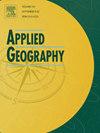Urban land-population-economy simulation model: Transitioning from 2D to multidimensional dynamics with cyclic feedback
IF 4
2区 地球科学
Q1 GEOGRAPHY
引用次数: 0
Abstract
Urban systems are complex, characterized by dynamic interactions between land, population, and economy. Recognizing the need to bridge physical and social spaces in urban simulations, existing research primarily focuses on large-scale regional models but often lacks effective city-level analysis frameworks. To address this gap, we introduce an innovative urban land-population-economy coupling simulation model.
Specifically, the model integrates XGBoost with an enhanced Cellular Automata (CA) framework to optimize spatial distributions across commercial, residential, industrial, and other land-use types. The Multi-output Gaussian Process (MOGP) algorithm simulates population and GDP distributions, improving accuracy through density mapping. A cyclic feedback mechanism iteratively updates driving factors for land-use development. Furthermore, tailored scenarios for distinct urban growth patterns—natural, compact, and sprawl—demonstrate the model's adaptability, achieving a Kappa value of 0.6947, an OA of 0.9250 and a FoM of 0.1857. Indicators like Local Mean Similarity (LMS) and Spatial Aggregation Index (SAI) further validate the model, establishing its robustness as a tool for urban planning and policy development.
城市土地-人口-经济模拟模型:从二维动态到多维动态的循环反馈
城市系统是复杂的,其特点是土地、人口和经济之间的动态相互作用。认识到需要在城市模拟中架起物理空间和社会空间的桥梁,现有的研究主要集中在大规模的区域模型上,但往往缺乏有效的城市级分析框架。为了解决这一差距,我们引入了一个创新的城市土地-人口-经济耦合模拟模型。具体来说,该模型将XGBoost与增强型元胞自动机(CA)框架集成在一起,以优化商业、住宅、工业和其他土地利用类型的空间分布。多输出高斯过程(MOGP)算法模拟人口和GDP分布,通过密度映射提高精度。循环反馈机制不断更新土地利用发展的驱动因素。此外,针对不同城市增长模式(自然型、紧凑型和蔓延型)量身定制的场景显示了模型的适应性,Kappa值为0.6947,OA为0.9250,FoM为0.1857。局部平均相似度(LMS)和空间聚集指数(SAI)等指标进一步验证了该模型,确立了其作为城市规划和政策制定工具的稳健性。
本文章由计算机程序翻译,如有差异,请以英文原文为准。
求助全文
约1分钟内获得全文
求助全文
来源期刊

Applied Geography
GEOGRAPHY-
CiteScore
8.00
自引率
2.00%
发文量
134
期刊介绍:
Applied Geography is a journal devoted to the publication of research which utilizes geographic approaches (human, physical, nature-society and GIScience) to resolve human problems that have a spatial dimension. These problems may be related to the assessment, management and allocation of the world physical and/or human resources. The underlying rationale of the journal is that only through a clear understanding of the relevant societal, physical, and coupled natural-humans systems can we resolve such problems. Papers are invited on any theme involving the application of geographical theory and methodology in the resolution of human problems.
 求助内容:
求助内容: 应助结果提醒方式:
应助结果提醒方式:


